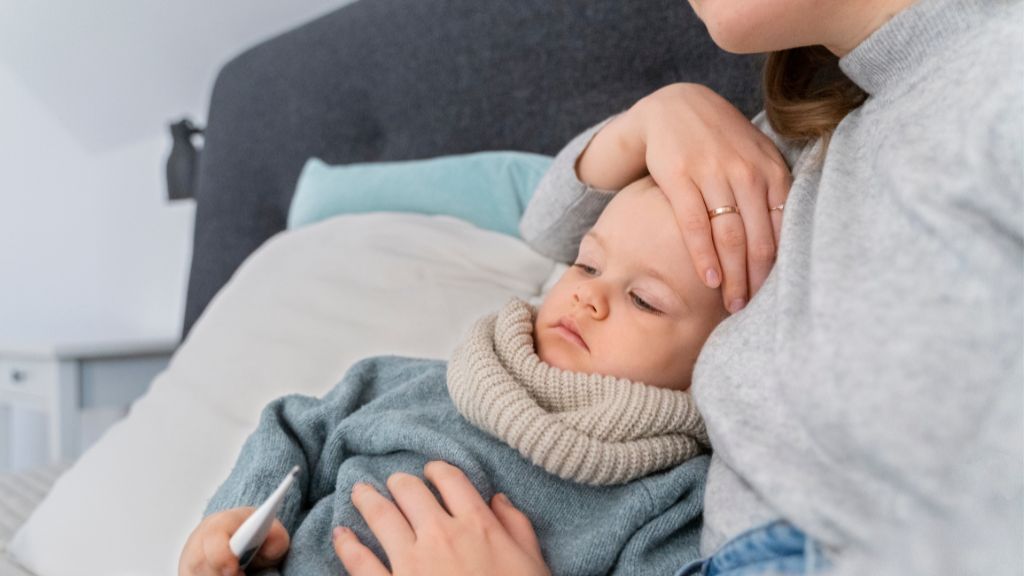Infectious diarrhoea is common, especially in areas with poor hygiene. It remains one of the leading causes of child mortality in underdeveloped countries. In communities with better access to clean water, sanitation and healthcare, the illness is less frequent and typically milder. In urban environments, viral causes like rotavirus and norovirus are most common and are spread via the fecal-oral route. Bacterial infections linked to unsafe food or poor hygiene can still occur, especially in young children.
Clinical profile of diarrhoea
Diarrhoea is defined as frequent defecation accompanied by an increase in stool volume and humidity. It is important to bear in mind that the stool of a healthy person also demonstrates significant variations in frequency and consistency, which is why diarrhoea is understood to be an intestinal disorder which meets the previously listed criteria. The stool can be slightly less dense or even completely “watery”, and sometimes contains traces of mucus or blood. Typically, its odour changes as well (ranging from acidic to rotten), accompanied by an increase in gas production. The more prominent the changes in stool frequency and density, the greater the chances that the diarrhoea will be accompanied by painful stomach cramps and a frequent urge to defecate.
Diarrhoea can also be accompanied by symptoms of respiratory tract infections (especially in children), fever, shaking fever and vomiting.
What causes diarrhoea?
Diarrhoea occurs as a result of the stimulation of the small intestine mucosa. Attempts to eliminate germs (bacteria, virus, toxins) lead to an increase in fluid and mineral secretion, and an acceleration of intestinal activity/discharge. Simultaneously, immune cells in the mucosa try to neutralise the germs, triggering an inflammation. Consequently, the intestinal villi are damaged (the tip, sometimes even the majority of the villus, rots away). It should be noted that the intestinal villi contain enzymes which digest food; this means that the child’s ability to digest food becomes limited. Particularly difficult is the digestion (decomposition) of sugar which, in its undigested form, absorbs water, thus exacerbating the recovery of the intestinal villi.
The chemical compounds (toxins) in some germs indirectly affect the complex mechanisms of discharging water and minerals in the mucosa, thus causing excessive losses. Consequently, the entire organism quickly loses fluids (dehydration) and suffers from the resulting electrolytic imbalance (hyponatremia, acidosis – increased acidity of the blood), all of which have an immediate effect on the overall condition and the level of awareness of the person or child who suffers from the illness.
How to cure diarrhoea?
Diet change
Unfortunately, many people still turn to the so-called BRAT (bread, rice, apple and tea) diet, even though evidence of not only its inefficiency but also of its harmfulness has been available for more than two decades. In order for the intestinal mucosa to recover, food intake is necessary. As a rule, meals should be smaller and slightly more frequent than usual. Sweet food and drinks should be avoided as concentrated sugars are not recommended. Non-sweet fruit (apple, banana), cooked vegetables and meat (soup, stew) with olive oil, cereals (bread) and dairy products (fresh cheese, yoghurt, kefir, sour milk, butter) should be consumed, while fried, fatty and spicy food should be avoided.
Infants who are exclusively breast- or formula-fed should continue with their usual feeding regime.
Unfortunately, attempts to cure diarrhoea with Cola drinks are still quite common; these are completely inappropriate due to their inefficiency and the damage they cause to the infected intestinal mucosa.
Oral rehydration solution (ORS) – thorough diarrhoea therapy!
Most important among available cures for diarrhoea are rehydration salt solutions. In addition to minerals, these solutions also contain a small amount of sugar which significantly stimulates the resorption of water and minerals from the intestines into the organism. Salt solutions without added sugar are nowhere near as effective in preventing and curing dehydration. This several-decades old discovery must have saved hundreds of thousands of lives around the world.
ORS should be administered as soon as the diarrhoea (or vomiting) begins – do not wait for symptoms of dehydration to appear. It should be noted that ORS will also shorten the duration of the diarrhoea. Moreover, it is an excellent choice in other situations of increased loss of fluid and salt (summer heat, intense sports activities, etc.).
How much fluid should one drink? Generally speaking, as much as the person experiencing diarrhoea wants. Instances of intense dryness of the oral cavity (dry and coated tongue, scant and sticky saliva) typically indicate a 5 to 10% liquid loss. This means that in the course of 6 hours, a child weighing 10 kilos should make up for the loss of around 0.5 to 1 litre of fluid, all the time compensating for current losses (stool, urination, perspiration, vomiting) as well.
Advice for home care and treatment of a child with diarrhoea
Give the child more fluids than usual:
do not stop breastfeeding water (boiled and then cooled); provide water with food that contains salt liquid food: pap, soup ORS (following the doctor’s instructions) give the child as much liquid as he or she wants; continue administering ORS (following the doctor’s instructions), until the diarrhoea ceases.
- for children under the age of two: 50–100 ml for each watery stool (administer fluid with a small spoon every 2 minutes);
- for children aged 2–10: 100–200 ml for each diarrhoea stool (to be drunk from a cup in small sips);
- for children over 10: as much as they want.
ORS should also be consumed even after rehydration has been achieved, until the diarrhoea ceases. This will speed up the recovery of the intestinal mucosa and reduce the duration of the diarrhoea!
In the event of vomiting, liquid intake should be interrupted for 10 minutes, and then continued, albeit at a slower pace.
Give the child enough food to prevent malnourishment and dehydration:
the choice of food depends on the age of the child, on their tastes in food and eating habits prior to the illness breastfed children should continue consuming their mother’s milk; breastfeeding sessions should be more frequent (reduce their duration only if the child is vomiting) in addition to milk, children older than 6 months can also be given cereals, vegetables, meat, fish and potassium-rich food (bananas, tomatoes, juice made from fresh fruit).
The food must be well cooked, strained and ground, with 5 – 10 ml of vegetable oil added to each meal. The child should be given as much food as they want. Offer the child food at least every 3 to 4 hours for two weeks after the diarrhoea has ceased, the child should be given at least one meal more than they usually consume if the child is malnourished, the additional meals should continue until the child regains the weight appropriate to their age.
Probiotics
Bacterial probiotics of the Lactobacillus and yeast (Saccharomyces boulardii) groups are most commonly used. In cases of acute diarrhoea, these microorganisms stimulate the natural processes of combating the infective agent of the diarrhoea. Numerous studies indicate that their application reduces the duration of acute diarrhoea by one day. These innocuous microorganisms do not cause side effects. However, caution is necessary in the case of patients with weakened immune systems as this condition may enable the probiotic microorganisms to enter the blood stream from the intestine, thus causing life-threatening infections (sepsis, myocarditis – inflammation of the heart muscle, meningitis).
Positive effects can also be expected in the treatment of antibiotic-associated diarrhoea. It should be noted that the administration of probiotics should come with the longest possible delay in relation to the administration of antibiotics, otherwise the antibiotics will end up destroying the probiotics as well. Probiotic yeasts are not sensitive to antibiotics and may be applied regardless of the dosage of individual antibiotics. Commercial fermented dairy products with added probiotics typically do not contain a sufficient amount of probiotics to cure diarrhoea.
Enteroadsorbents
Enteroadsorbents are chemically inert compounds. They cannot enter the blood or lymphatic system from the intestines. Instead, they are completely eliminated through defecation. The most effective among these seems to be a preparation containing organic silicate – a mineral which binds toxins and the causative agents of diarrhoea. Since it consists of hydrophobic molecules, it does not “stick” to the intestinal mucosa, thus creating better conditions for its recovery. In addition, the “healthy” bacteria which are typically stuck to the mucosa stay there (enteroadsorbents will not eliminate them). This creates optimal conditions for reducing the duration and intensity of the diarrhoea. Generally odourless and tasteless, enteroadsorbents can be given to pregnant women and children of all ages (including infants).
Antisecretolytic – “smart cure” for effective diarrhoea treatment
The medication racecadotril is available in Croatia. It works by blocking chemical compounds that are produced in the intestinal mucosa during infection. These compounds cause excessive loss of water and minerals into the intestinal lumen. It does not slow down intestinal activity (peristalsis). This helps the body eliminate infection-causing agents effectively through stool. Racecadotril is not resorbed – in other words, it does not enter the blood stream from the intestines. It has a pleasing taste and children respond to it favourably.
This medicine effectively reduces the number and volume of stools which is especially helpful in cases of diarrhoea accompanied by a large number of soft, watery stools and cramps. It can be given to children older than three months. It is not recommended for pregnant and nursing women since there has been insufficient research on its effects on those groups of patients. This medicine is intended as an addition to basic diarrhoea therapy (oral rehydration solution). Persons travelling to areas with lower hygiene standards and greater frequency of contagious diarrhoea are advised to take with them these medications – powder for preparing a rehydration solution and racecatordil.
When to call a doctor about diarrhoea?
Immediately contact emergency services if:
- the child is lying motionlessly or is too weak to stand up
Immediately contact your doctor if:
- your child appears to be seriously ill
- s/he is showing symptoms of dehydration (e.g. s/he has not urinated for more than 8 hours, does not produce tears while crying and has a very dry mouth)
- there is blood in his/her stool
- s/he has a fever over 40°C
- s/he is younger than 12 weeks and his/her rectal temperature is over 38°C
- s/he has had stomach pain for more than 2 hours
- s/he has vomited more than three times
- s/he is below the age of one month and has had more than 3 plentiful, watery stools
- s/he has had more than 8 stools in the past 8 hours
- s/he is experiencing acute diarrhoea that might be caused by medicine (e.g. antibiotics).
Contact your doctor during office hours (within 24 hours):
- if you think the child needs a medical check-up
- if mucus and puss have appeared in the child’s stool for more than two days
- if the child who has already learned to control his/her stool has uncontrollably defecated more than three times
- if the fever continues for more than three days
- if there has been close contact with a person suffering from bacterial diarrhoea.
Contact your doctor during office hours:
- if you have any further questions
- if the diarrhoea lasts longer than two weeks or occurs frequently.
Treatment and parental care at home without consulting a doctor:
- if the diarrhoea is mild (probably viral gastroenteritis – stomach flu) and you do not think a medical examination is necessary.
General recommendations
Handwashing
Handwashing effectively prevents the spread of germs (bacteria, viruses and parasites) and as such presents the most important part of daily hygiene. Adopting the proper handwashing technique among children (and the whole family) provides effective protection against numerous diseases. In developed communities, diarrhoea caused by unhealthy water and food is rare. Instead, germs are most commonly transmitted by hands.
Washing your hands with clean, running water and soap (liquid soap is recommended over ordinary soap) provides the best protection. However, if water and soap are temporarily unavailable, hand sanitisers (liquid or gel) can also provide good protection.
When should you wash your hands?
- Before, during and after preparing food
- Before eating
- Before and after infant care
- After blowing your nose, coughing or sneezing
- After using the toilet
- Before and after caring for a sick person
- After changing diapers or wiping a child who has used the toilet
- After handling garbage
- After handling money
- Before and after treating a wound (cut, scratch, burn)
How should you wash your hands?
- If you are wearing rings, take them off before washing your hands.
- Wet your hands with clean running water (cold or warm) and apply soap.
- Lather your hands by rubbing them together with the soap. Make sure the backs of your hands, the area between the fingers and under the nails is thoroughly lathered as well.
- Scrub your hands for at least 20 seconds (the approximate time needed to hum “Happy Birthday” from beginning to end twice).
- Rinse your hands thoroughly under clean, running water.
- Dry your hands using a clean towel (paper towels are the safest, but an ordinary towel can alternatively be used) or air dry them.
- Use a paper towel to turn off the faucet.
Washing your hands with water and soap is the most effective way to reduce the number of germs on them. If water and soap are unavailable, use a hand sanitiser and thoroughly rub it over all the surfaces of your hands and fingers (pay special attention to the palms, the backs of the palms, the area between the fingers and under the fingernails). Alcohol-based disinfectants (with a minimum of 60% alcohol) quickly reduce the number of germs, but do not to eliminate all types of germs. Furthermore, they are less effective on visibly dirty hands. Look for disinfectants with an increased power of eliminating microorganisms, especially if you find yourself in areas with lower hygiene levels. To additionally prevent the transmission of germs, avoid putting your hands or various objects into your mouth. This lesson is particularly important for children.
What does science have to say about the effectiveness of preventing the “dirty hands disease”?
Numerous studies have shown the undisputable link between infections of the skin, the digestive and respiratory tracts on the one hand, and insufficient hygiene on the other. Among preschool children, an estimated 75% of respiratory tract infections are transmitted by hands. In addition to washing the hands with running water and soap, coughing and sneezing into your sleeve (into the elbow) also significantly reduces the spread of germs (putting your palm or handkerchief over your mouth and nose is less effective). Cotton handkerchiefs are less efficient than paper tissues.
Applying hand sanitiser after you have washed your hands with water and soap reduces germ transmission by an additional 30%, which is why this practice is recommended in institutions such as hospitals and places where children come together in groups. Disinfecting toys and work surfaces in kindergartens also has measurable protective effects. Infrequent washing of bed linen in nurseries and kindergartens (less than once a week) is linked to a higher frequency of respiratory tract inflammations.
Appropriate education of children on these topics reduces the frequency of infectious diseases.
Immunisation against diarrhoea
A common cause of acute infections of the digestive tract accompanied by fever, vomiting and diarrhoea is the rota virus. There are several types of the virus, which means the infection can occur multiple times. The most severe forms are found among small children, while, with adults, each subsequent infection (caused by a different type of the virus) is milder. The problem with the virus is that it travels through the air and is highly contagious. If you have not had this illness and you have no immunity, it is enough to enter a room inhabited by an ill person – and there is a 98% chance you will be infected. The usual hygienic measures (handwashing, disinfecting toilet facilities, tables, toys, floors) will reduce the chances of infection by only a few percent. In the majority of cases, children get infected after first joining other groups of children (infant nursery, kindergarten).
In Croatia, there is a vaccine that prevents the development of a severe form of this disease with an almost 100% success rate. Infection is possible even after immunisation, but, if it does occur, it is reduced to only a few softer stools a day. The immunisation is given orally (in the form of drops) in two doses; it is administered to children aged 6 weeks to 6 months and has no significant side effects (sometimes softer stools can occur and last for a few days). The immunisation has to take place before the child reaches the age of six months (there is no evidence of the vaccine being effective when administered later in life).
Download LittleDot – Your Family’s Health Companion!
Easily manage your family’s health with our all-in-one app. Track medical records, consult with doctors, and stay ahead of every health need. Convenient, reliable, and always within reach. Download now and try it for free!







